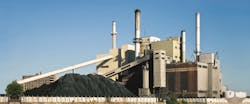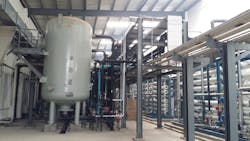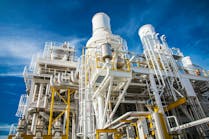Plant offers wastewater recycling, zero liquid discharge solution for coal-based new materials project in China
By CK Tiwari
A key part of Chinese energy policy is to ensure security of supply. This is a critical issue since the country is rich in coal resources but has comparatively limited supplies of oil and natural gas. Over the last decade, the Chinese economy has undergone a rapid and extensive industrialization, which has been fueled to a very significant degree through an exponential increase in coal use. At the same time, there has been a significant increase in the use of petroleum products in the transport sector, with oil and gas often being the starting point for transformation to other key products in the chemical sector.
As it has grown, China has significantly increased both chemical production and consumption. The increasing demand for oil and gas as well as the need to maintain supplies of chemicals and other products, which cannot be met from domestic sources, represents a potentially significant energy security issue for China. The government is implementing a wide range of measures to secure oil and gas from a diverse range of sources while also introducing energy efficiency measures in various production processes.
As part of this initiative, there has been a strong interest in using coal rather than oil or natural gas as an alternative raw material for the production of transport fuels, gas and chemicals. Consequently, since 2004, China has embarked on a structured program of research and development, together with large-scale demonstrations, leading towards the establishment of a coal-based transformation industry commonly referred to as Coal-to-X (CTX), to replace, at least in part, the use of oil and gas in the various fuel and chemicals sectors.
The biggest threat for further development of this industry is its relatively high level of pollution. In comparison, the petrochemical industry can produce the same chemicals as the coal-to-chemicals industry but with much lower levels of pollution. Given the recent focus on environmental issues in China, the government has imposed stringent regulations wherein any new project proposal has to include a water management plan that includes the recycle and reuse of the wastewater in a zero liquid discharge (ZLD) configuration.
To reduce its carbon and water footprint and to ensure statutory compliance, Shenhua Coal Oil Chemical Co. implemented a project to recycle water from wastewater generated by its CTX plant in Xinjiang, China.
The Project
To reduce its carbon and water footprint, and to ensure statutory compliance, Shenhua Coal Oil Chemical Co. Ltd implemented a project to recycle water from wastewater generated by its 680 KTA Coal-based New Materials Project in Urumqi City of the Xinjiang Uygur Autonomous Region in China. The new proposed system was required to eliminate wastewater discharge with a ZLD configuration.
However, CTX wastewater is a very complex waste with high levels of organics, silica, ammonia and hardness, which leads it to have a high scaling/fouling potential for a membrane system, which would be the primary technology used for recycle/reuse applications. A conventional membrane technology would be severely limited in its recovery due to the high scaling potential of the feed water, resulting in high reject volumes requiring a very large ZLD system to treat.
Shenhua Xinjiang selected Aquatech International to design, engineer and supply the wastewater recycling and ZLD system for this project, as well as to supervise installation and commissioning. Aquatech has experience and expertise in commercially proven ZLD solutions on six continents, including several projects in China, that completely eliminate discharge of water from plant operations into the environment by converting it to disposable dry solids and high-quality water for reuse. The company is also an innovator in ZLD technologies and a pioneer in hybrid ZLD, which combines membrane technologies and thermal evaporation systems to provide a reliable and cost-effective solution.
For this project, Aquatech supplied a fully integrated and automated system with AquaEZ™, a proprietary state-of-the art technology solution developed specifically for the CTX market. The solution consists of High Efficiency Reverse Osmosis (HERO™) followed by high-efficiency evaporation and a crystallizer to eliminate liquid discharge from the plant.
The AquaEZ technology provides a robust and cost-effective solution for very complex applications with the following attributes:
• Reliable solutions to handle difficult effluent chemistry with high chemical oxygen demand (COD), total dissolved solids (TDS), and silica
• High availability
• Low CAPEX and OPEX
• Small thermal portion
The AquaEZ solution for the Shenhua Xinjiang project consists of three components: water recycling, zero liquid discharge and recycle water post-treatment.
Aquatech’s AquaEZ technology solution consists of High Efficiency Reverse Osmosis (HERO) followed by high-efficiency evaporation and a crystallizer to eliminate liquid discharge from the plant.
Water Recycling
The CTX wastewater stream has high scaling and fouling potential due to the presence of hardness, organics, ammonia, silica, and other constituents. The wastewater stream is first concentrated by the HERO system, consisting of lime softening, filtration, ion exchange, ultrafiltration, and RO membranes, achieving a high recovery of low TDS permeate for reuse by the CTX facility.
HERO is a patented process that is most suited for applications where feed water is high in both organic and inorganic foulants. The operating environment of a HERO system eliminates scaling and fouling by biological growth, organic species, and oil and grease. The result is that an AquaEZ system requires less downtime for cleaning than a conventional RO-based wastewater treatment system.
The process allows the evaporator to run in a high-efficiency, unseeded mode, with the following advantages:
• This mode does not require 100 percent standby to be reliable, as is the case with a seeded system. This is a considerable benefit since downtime for cleaning of a seeded system is two weeks.
• No mechanical cleaning of the evaporator is required.
• Due to the high pH, metallurgy is optimized, which results in lower costs.
• There is no downtime due to scaling.
• A Clean-in-Place (CIP) system washes soft scales off the evaporator every three months.
Zero Liquid Discharge
The concentrated brine from the water recycling system is further concentrated in the ZLD system, recycling the remaining water as distillate. The ZLD system comprises a high-efficiency evaporator for brine concentration and crystallizer to achieve ZLD.
The concentrated HERO reject brine from the water recycling system is non-scaling. The evaporator is designed with a very low ΔT (temperature difference between the heating medium and the boiling brine) and a high recirculation rate. The result is scaling-free evaporator operation and lower power consumption. This significantly increases the uptime for the system compared to a conventional seeded slurry approach for such applications where the evaporator has to be taken offline for cleaning once every 3 to 6 months for couple of weeks.
The final brine concentration step is the crystallizer, which further concentrates the brine from the evaporator. As concentration occurs, salts are precipitated, grown into crystals and harvested by a centrifuge. The dry salt is taken for suitable disposal.
Recycled Water Post Treatment
Permeate from the water recycling system and distillate from the ZLD system is treated to reduce ammonia (NH3) and TOC to specified limits. A stripping tower is used to treat the distillate, and the combined distillate and permeate is treated by activated carbon and strong acid cation (SAC) ion exchange columns. This water is then recycled and reused for the plant’s operation.
Summary
Aquatech was able to deliver an effective, reliable AquaEZ zero liquid discharge (ZLD) solution for Shenhua Coal Oil Chemical Co. Ltd’s Xinjiang CTX plant in China. It is key to the plant’s regulatory compliance and provides the plant with high-quality water for recycle and reuse. Shenhua’s wastewater solution is also an important example of a CTX plant’s ability to manage water effectively. IWW
About the Author: CK Tiwari is senior vice president and general manager of Aquatech’s Total Water Management group. To learn more, visit www.aquatech.com.
Circle No. 154 on Reader Service Card



